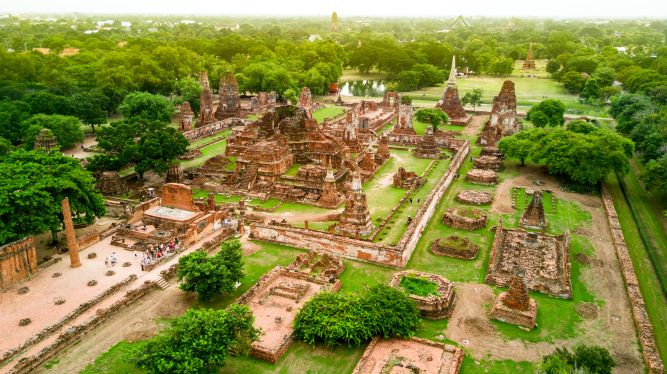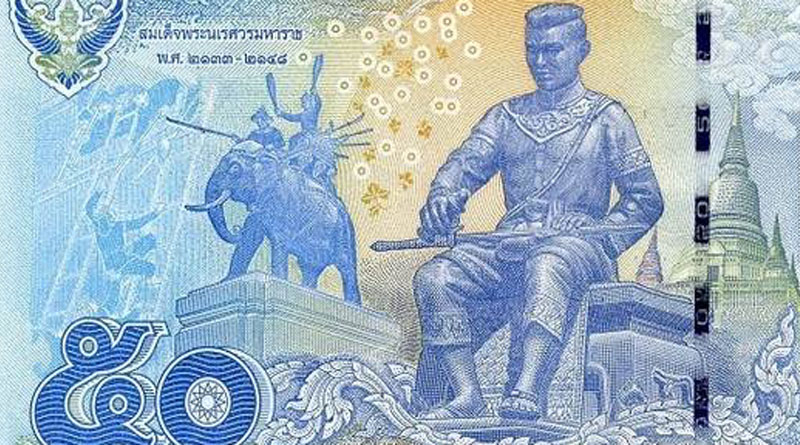The Kings of Ayutthaya
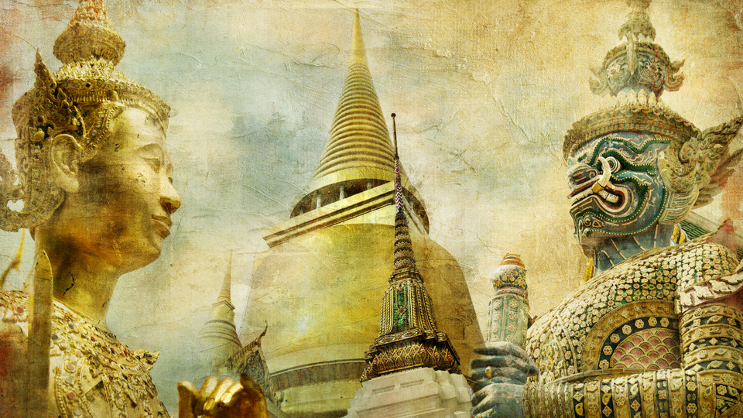
A book such as “The Kings of Ayutthaya” is, as it says on the cover, “A Creative Retelling of Siamese History.” As such it is my interpretation and the portrayal of events that together build to give a picture of Ayutthaya throughout the centuries. I am not steeped in Thai history and I feel that coming from outside perspective enabled me to interpret the history in a fresh manner and, hopefully, an accurate manner. Time has taken its toll on many historic records which are often incomplete or contradictory depending on the source. As the book concerns Ayutthaya I have tended to follow the Thai narrative in most instances.
https://silkwormbooks.com/collections/history/products/kings-of-ayutthaya
Our book begins with the foundation of Sukhothai set against the backdrop of a declining Khmer Empire which has governed the region, through their state of Lavo (Lopburi), for many years. With two armies looking to combine, one local and one from Angkor, the time to strike is before they merge. The defeat of these armies paves the way for the kingdom of Sukhothai. As the Khmer forces withdraw a power vacuum develops. It is one that Sukhothai is well positioned to exploit, which it does under the auspices of a number of competent and able kings.
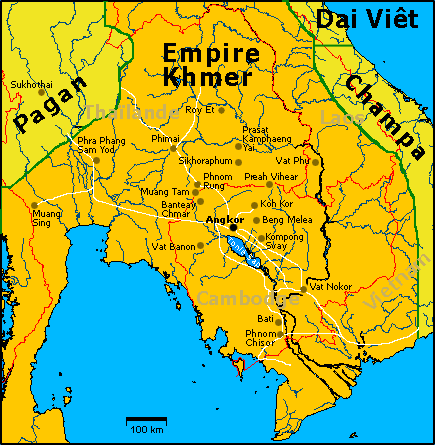
Our novel begins as the Khmer Kingdom in Angkor Wat started to decline. The story is told in my book "The Kings of Angkor." The birth of modern Thailand is marked by the founding of the great city-states of Sukhothai and Ayutthaya.
It was in the year 1238 that Tai chieftains came together and overthrew the Khmer at Sukhothai. Before that time Sukhothai formed a distant outpost of Angkor's northwestern province.
French Map of Khmer Empire under Jayavarman VII. Author: Lozère at French Wikipedia
The villages that merged to form Sukhothai lie along the central plain and sit either side of the Yom and Nan River basins. Evidence suggests that many of these villages had formed loose alliances as early as the year 1150. The area sat astride trade routes moving goods from the middle east into the south-east Asia region, and onwards to the south of China. The peace that came about by this loose union of villages enabled the area to prosper. The prosperity attracted the attention of the then fast expanding kingdom of the Khmer who annexed Sukhothai under its remit.
Tai warriors reinforced Sukhothai against the Khmer empire and fought to gain control of Sukhothai and the central plain that surrounded it. To the north another group of Tai warriors later conquered the Mon state of Haripunjaya founding the kingdom of Lan Na with its capital of Chiang Mai.
It was in the late thirteenth century when the people of the central plain first took the name “Thai,” meaning "free," in order to set themselves apart from other Tai speakers still held under foreign rule. The Thai have traditionally regarded the founding of the kingdom of Sukhothai as marking their emergence as a nation.
The decline of the Khmer and the eventual fall of its capital city of Angkor Wat is much debated. Religious change, the impact of the invasions of Kublai Khan in China, emphasis on building rather than improving irrigation, and a severe drought are perhaps some of the factors that led to the dominant power of the South-east Asia region losing the eminent position it had held in the previous centuries.
Sukhothai sits on the banks of the Mae Nam Yom River approximately 200 miles (approx. 340 kilometers) north of Bangkok. The kingdom of Sukhothai that developed is regarded as the cradle of Thai civilization. It was the city where Thai institutions and culture first coalesced. The Thai civilization of the period grew from a wide mix of cultures and traditions dating back to prehistoric times. Times influenced by a wide range of factors ranging from the existing Khmer social and architectural influence, the Mon Buddhism that flourished during the earlier Dvaravati period, the Brahmanical and Mahayana influence from the Indian sub-continent and the Malay Peninsula, and the influx of peoples driven southwards by the wars raging in China to the north. Opposite:The Pho Khun Si Inthrathit (Pho Khun Bang Klang Hao) Monument, Nakhon Thai, Thailand.
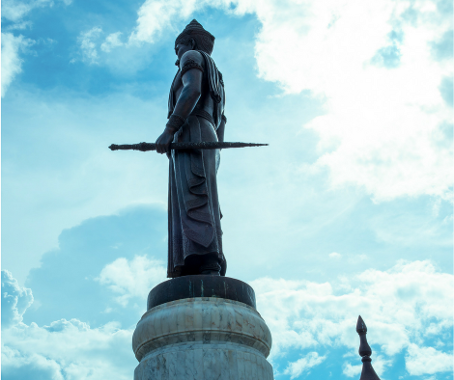
Both the Khmer Empire and the Sukhothai Empire have influenced the growth, the governance and the culture of the Kingdom of Ayutthaya. Our journey in this book begins where the nation of Thailand first developed its roots, in Sukhothai.
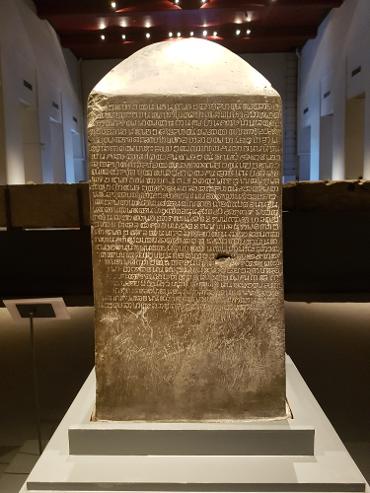
The first king of the unified state of Sukhothai was King Sri Inthrathit in the year 1238. It would be wrong to call Sukhothai a nation, as there was no sense of nationhood at the time, but the Kingdom of Sukhothai, despite being formed of any number of loose alliances, was extensive. The Inscription Stone, created by King Ram Khamhaeng gave the extent of the empire as spreading from the northern border to Phrae, Nan and Vientiane, while the south covered an area as far as Nakhon Si Thammarat, the east reached the Mons of Hongswadee in Southern Burma and as far west as the west bank of the Mekong River.
Opposite: The King Ram Khamhaeng Inscription Stone is perhaps the oldest surviving Thai language inscription. The text describes the life of King Ramkhamhaeng, details the systems of law and government of the Sukothai Kingdom.
The manner in which Pho Khun Pha Mu'ang offered the throne to King Si Inthrathit set the scene for what would become an enlightened kingdom. It was a time of plenty, but it was also a time when a number of factors conspired. Good harvests, new people fleeing the wars to the north and entering the kingdom keen to rebuild their lives, no one power filling the vacuum created by the retrenching Khmer, and a style of leadership revered to this day.
Statue of King Ram Khamhaeng the Great at Sukhothai National Park. The park covers the ruins of the kingdom of Sukhothai. The ruins are more contained than those of Ayutthaya and can be accessed by an open bus tour, walking, or on a bicycle (if it's not too hot!). Well worth a day of anyone's time. Both the ruins of Si Satchanalai and Ramkhamaeng National Park are within driving distance.
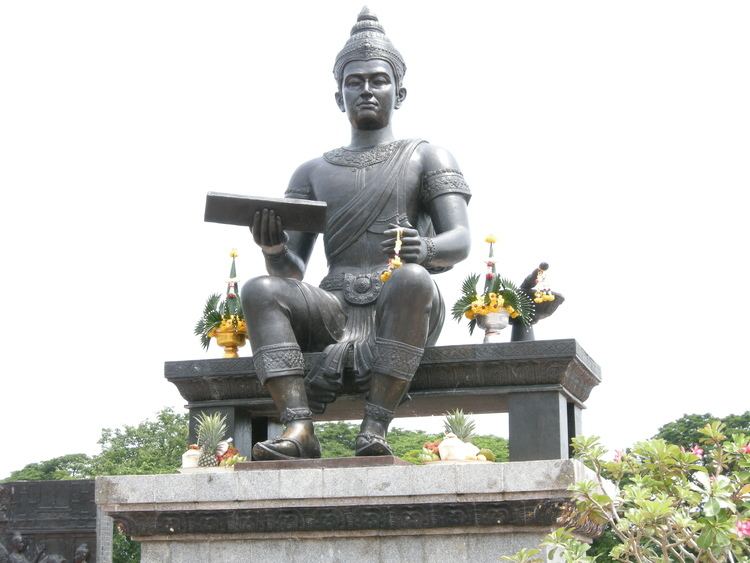
When Lopburi (the capital of the Khmer province of Lavo) fell under the remit of Sukhothai it clearly caused consternation in the city. Lavo had been a semi-autonomous state under of the Khmer Empire and ruled over much of the region that it was now subservient to. King Ram Khamhaeng was schooled in Lopburi, which was a center of education and religious thinking at the time. When Lopburi fell under his suzerainty the former slave was now the master. This becomes evident over the following centuries when Ayutthaya comes to dominate, the faction from Lopburi sees the conquest of Sukhothai as paramount, while the rival focus of the city ofSuphanburi is on the Khmer in Angkor.
The kingdom of Sukhothai was not only a devoutly Buddhist center, although vestiges of the old religions lingered, it also followed a “Pho” approach to government where the king is a father and acts in a benign and caring was toward his subject, his children. This approach was in contrast to that that became to norm in Ayutthaya which based its governance, religion and administration of the model adopted in Angkor where the king rules by divine right and aspires to become “Chakravartin”, a wheel-turning monarch, a universal and just ruler.
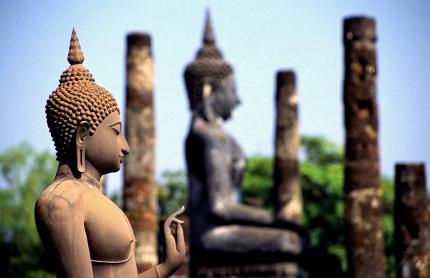
The term "chakravartin" derives from the dharma chakra or wheel of dharma, and refers to “he who turns the wheel” of dharma. He who maintains the universal law (dharma) across the whole world, or more practically the world under the king. The importance of the approach used in Sukhothai was that the goodwill within the term Pho continued through the generations and the centuries. Thai monarchs still use the term “Pho” as fathers of their people. The picture shows the sitting Buddha at the ruins of the Wat Chana Songkram temple in Sukhothai historical park.
The importance of the relationship between the king and the Sangha (the Buddhist priesthood) became one of mutual reliance. The monks could tell of the king to the people, and it was important that they knew and revered their king despite the fact they would never see him and know of him only through the stories told by the monks. The link between the king and the Sangha (the priesthood) strengthened both parties and it remains a strong bond to this day.
Opposite: The Three Kings Monument in Chiang Mai.
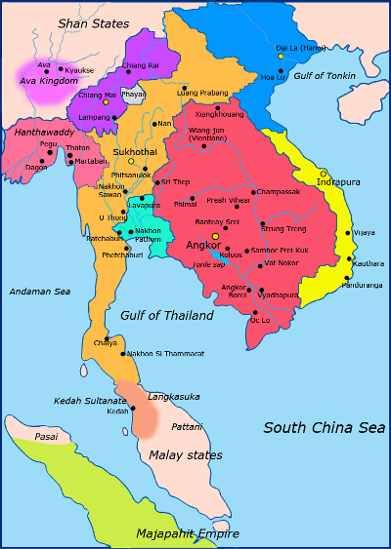
By the year 1300 the Kingdom of Sukhothai had pushed the Khmer Empire of Angkor back. It had secured its nothern border following the "Pact of Friendship" between the three kings and could concentrate on eastward and southward expansion. It had extended as far south as Ligor (Nakhon Si Thammarat) and east past Phitsanulok. The Mon kingdom of Hanthawaddy to the west paid homage to King Ram Khamhaeng.
Opposite:
Map of Southeast Asia circa 1300 CE, showing Khmer Empire in red, Lavo kingdom/Dvaravati in light blue, Sukhothai empire in orange, Champa in yellow, Dai Viet in blue, Kingdom of Lanna in purple and surrounding states. Author Javierfv1212.
After the fall of the Pagan Empire, modern day Burma, (1287) to the invading Mongols, the Mon, under King Wareru, regained their independence and captured Martaban and Pegu, regaining much of their previously held territory. The next 200 years witnessed incessant warfare between the Mon and the Burmans, but the Mon managed to retain their independence until 1539, when they came under the domination of the Burman Toungoo Empire. Both the Ayutthayan and the Burmans laid claim to the Mon lands, a region that became a battleground, particulary in the time of the Burman kings, King Tabinshwehti, King Bayinnaung, King Nanda Bayin and the Ayutthayan king, King Naresuan.
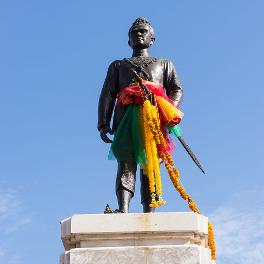
Statue of King Ramathibodi at Ayutthaya.The founding of the city of Ayutthaya is steeped in myth and legend, and while Sukhothai looked inward focusing on its religion, U-Thong founded Ayutthaya as King Ramathibodi. His rule, based on the Brahmin culture that so dominated the Khmer court, was at odds with the "Pho," father and son approach of Sukhothai. A collision was inevitable.
By the year 1400 Ayutthaya, founded in 1351 by King Ramathibodi, had pushed back the borders of Sukhothai and annexed their lands to the south as far as Ligor (Nakhon Si Thammarat.) The Khmer Kingdom of Angkor was under threat from both Ayutthaya to its west and Lan Xang to its north.
Map of Southeast Asia circa 1400 CE, showing Khmer Empire in red, Ayutthaya Kingdom in violet, Lan Xang kingdom in teal, Sukhothai kingdom in orange, Champa in yellow, Kingdom of Lanna in purple, Dai Viet in blue and surrounding states. Author: Javierfv1212
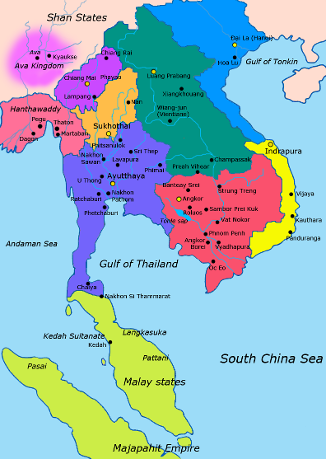
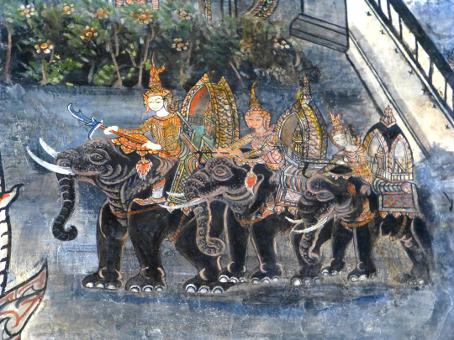
The Ayutthayan chronicles record that King Borommaracha II attacked Angkor in 1431. He is reported to have had a large number of sacred images and relics removed from the temples there. These images were brought to Ayutthaya and installed as offerings at Wat Maha That and Wat Si Sanphet. Opposite may be a mural of those events recorded on the walls of Wat Kasattathirat.
A fine collection of Ayutthayan drawings and photographs can be found at:
https://www.photodharma.net/Thailand/Ayutthaya-Wat-Kasattrathirat/Wat-Kasattrathirat.htm
The interplay between Lopburi and Suphanburi provided the backdrop for many of the events over the coming years with Suphanburi often the dominant player. It was a conflict that rose again many centuries after the founding of the city when the Lady Si Suda Chan made her ill-fated play for power. I must admit I did enjoy writing about her!
As the kings came and went various consistencies emerge. The taking of people from conquered lands. The land was readily available. Wars of the period were not about territory as much as about taking people to farm the land or work as craftsmen or artisans. The lingering Brahmin concept of mandala, or field of influence, protecting your borders with strategically placed cities which, perhaps, could serve to stop the building of nations by allowing too much independence to those cardinal cities.
Opposite: A statue of King Naresuan the Great
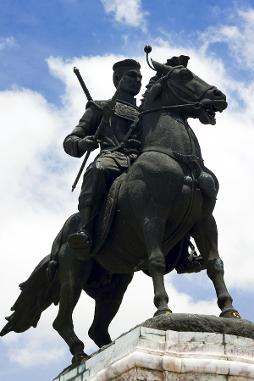
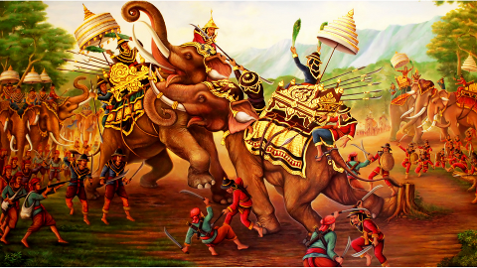
The independence of cities while being considered under the suzerainty of Ayutthaya was one that was not fully addressed until the reign of King Ekathotsarot, and was most telling seen when Khun Phirenthrathep, later King Maha Thammaracha came to the aid of king Maha Chakkraphat when he was under siege by King Tabinshwehti, and later when King Maha Thammaracha acted independently when Ayutthaya was under siege by King Bayinnaung of Hanthawaddy.
Opposite: The battle between King Naresuan and Mingyi Swa that finally drove the Burman from the Kingdom of Ayutthaya.
Wat Chaiwatthanaram viewed at night. The Wat sits on the bank of the Chao Phraya river, to the west of the city island. It was built in 1630 by King Prasat Thong to honor his mother, featuring the architectural style influenced by Angkor temple in Cambodia—its unique feature is a large, central prang (Khmer-style pagoda) surrounded by smaller prangs, symbolizing Mount Sumeru, the gods' mountain according to Hindu belief. The lighting at night makes the temple seem more exotic and beautiful.
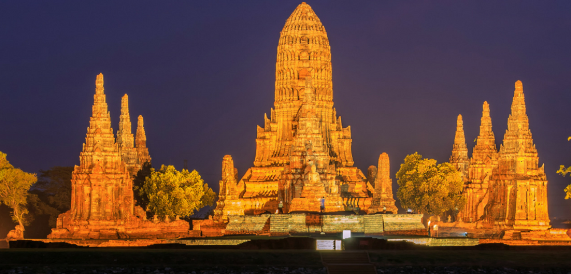
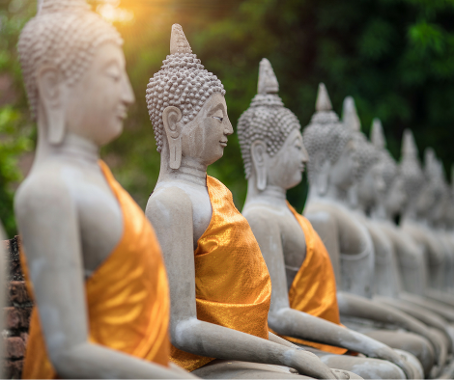
Ancient Buddha Statues at Wat Yai Chai Mongkol
The importance of the relationship between the king and the Sangha (the Buddhist priesthood) became one of mutual reliance. The monks could tell of the king to the people, and it was important that they knew and revered their king despite the fact they would never see him and know of him only through the stories told by the monks. The link between the king and the Sangha strengthened both parties and it remains a strong bond to this day.
A Buddha image is traditionally consecrated at dawn. Wax covering the eyes of the image is removed, and the sun's first rays, breaking through the eastern entrance doors of the temple, strike the golden image. Meanwhile monks chant a verse proclaiming that one who knows the truth as taught by the Buddha can ward off evil, just as the dawn drives away darkness and fills the air with light.
The consecration of the image is a reenactment of another event that occured at dawn: Sakyamuni Buddha's final victory over evil some 2500 years ago in India. The Buddha at this time of his victory is the subject of this image, and of almost every primary image in the monastaries of Thailand. The Buddha's right arm is lowered in the gesture that brought forth a flood that carried away the evil forces. The waters of the oceans comprimised this flood, and they were equivalent to the good deeds the Buddha had performed in his past lives. The kingom of Sukhothai developed a new curvilinear style of image in the 14th century, which is now highly regarded.
The hand positions of the buddha are highly symbolic. The Abhaya Mudra, the position of fearlessness, is made with the open palm of the right hand extending outwards at the chest level or slightly higher and the left hand laid upwards on the sitting torso. Mudra Bhumisparsha translates into 'touching the earth' or the 'earth witness' mudra. This mudra, formed with all five fingers of the right hand extended to touch the ground, symbolizes the Buddha's enlightenment under the bodhi tree, when he summoned the earth goddess, Sthavara, to bear witness to his attainment of enlightenment. The right hand, placed upon the right knee in earth-pressing mudra, and complemented by the left hand-which is held flat in the lap in the dhyana mudra of meditation, symbolizes the union of method and wisdom, samasara and nirvana, and also the realizations of the conventional and ultimate truths. It is in this posture that Shakyamuni overcame the obstructions of Mara while meditating on Truth.
Walters Art Museum [Public domain, CC BY-SA 3.0 (http://creativecommons.org/licenses/by-sa/3.0)
With Ayutthaya being protected by the Chao Phraya, the Lopburi and the Pa Sak rivers waterbourne transport was essential for its existence. Ships could sail inland from the sea and goods and foodstuffs could be transported along the network of rivers. The position of Ayutthaya at the confluence of three major river was one of the major keys to its success.
17th Century French drawing
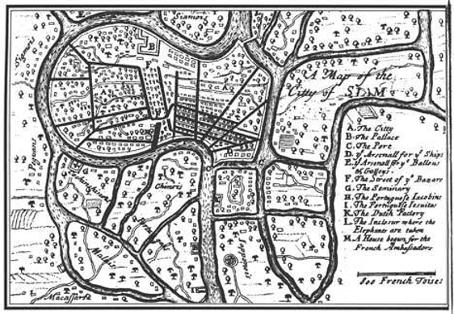
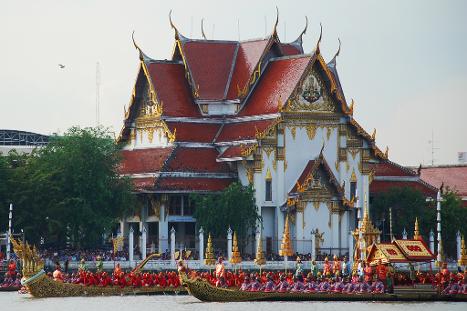
The Royal Barge Procession held on 9 November 2012
The text relates the story of King Intharacha having a new royal barge built. This was a major undertaking with the resultant boat judged against those built previously. His barge, in the text, was based on the tiger. The tiger is now vilified in Thai culture following the reign of the “Tiger King” but that was not the case in these early days. King Borommaracha commanded that the ceremony of Asayuth be held where boat races took place and culminated in the race between the queen's royal barge and the king's. The king being expected to lose. A fascinating glimpse into the importance of the lives of the kings and into the role of the rivers in Ayutthayan society.
King Trailok was one of the most influential kings of the early/middle Ayutthayan period. He stands out as an able king and a deep thinker. His influence on the structure of society by promulgating the "laws of the palace," or the "sakdina system" as they are more commonly known built upon existing conventions and formalized a structured society that still influences Thai thinking today. His reign, under threat from a resurgent King Tilokkarat in Lan Na, ushered in many changes and stabilized Ayutthaya for many years to come.
One question put to me is why did I include the story of Prince Wetsandon? The very fact that that question was asked is the reason. More than anything else the tale illustrates the different values and perspectives of the society of the time. It is easy to judge the prince's actions from a western perspective, however, the view of the time shows him, not as someone who was foolish and taken advantage of, but as someone who would give everything for the well-being of others. A trait revered in Buddhist society. The picture shows the prince giving away his cart to the Brahim priest.
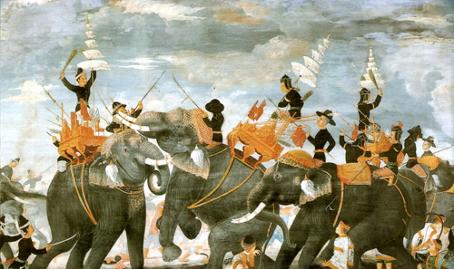
The battle on Lumpli Plain where Queen Suriyothai and Princess Boromdhilok gave their lives supporting King Maha Chakkraphat.
The book is billed as “A Creative Retelling of Siamese History.” It does not always follow the expected Thai narrative. One case in point is King Maha Thammaracha who is often viewed in Thailand as a traitor in failing to support King Maha Chakkraphat in his fight against King Bayinnaung. There is no doubt he made a conscious decision not to go to his aid, despite aiding him both in his succession to the throne and when Ayutthaya was attacked by King Tabinshwehti.
Opposite: Painting of the Battle between Queen Suriyothai and the Viceroy of Prome in the Burmese-Siamese War of 1548-49. Painted 400 years later. By Prince Narisara Nuvadtivongs
As I have mentioned earlier on this website “The Kings of Ayutthaya” is in many ways, a development of my earlier novel “King Naresuan the Great.” I considered adapting my text for “King Naresuan the Great” into “The Kings of Ayutthaya” but when you have spent so much time and effort trying to ensure the text reads as you like it I finally accepted that the relevant text should be incorporated into “The Kings of Ayutthaya.” That decision meant that, unfortunately, I had to de-list the novel King Naresuan.
King Naresuan is Thailand's national hero and his victory of the Burmese crown prince Mingyi Swa is commemorated each year on the Royal Thai Armed Forces Day on January 18th or a surrounding date each year. The stories that surround him are the truth intermixed with myth, legend and exaggeration. He led Ayutthaya to freedom against the Hanthawaddy and was a man of proven military ability. His role is viewed from the Burman perspective in my third novel in the series "The Kings of the Toungoo Empire.”
The white elephant, which need not be white, has long been a symbol revered throughout South-east Asia. It plays a part in two notable incidents in the history of Ayutthaya. The first is when Prasuja Akara Devi of Suphanburi gifed a white elephant to King Borrommacha I. The animal sickened and died casting a blight over the reign of the king. The second is when the Burman king, King Bayinnaung asked that the king of Ayutthaya, King Maha Chakkraphat send him two white elephants. In doing so, King Maha Chakkraphat would have accepted the overlordship of the Toungoo Empire. The request was, in effect, a declaration of war.
King Bayinnaung forged his empire, the largest empire ever seen in South Asia, after securing his throne following the death of King Tabinshwehti. He did it using force, skill, guile and brutality. In his conquest of Ayutthaya he was motivated by loyalty to his friend King Tabinshwehti who had failed in his earlier bid to conquer the city and by a desire to bring the Theravada Buddhism as practiced in Sri Lanka to the territories he conquered. He viewed Ayutthaya as not being rigorous in the way the faith was being applied.
Statue of King Bayinnaung in front of the National Museum of Myanmar
King Bayinnaung was the third king of the first Toungoo Empire, which ended with his son Nanda Bayin. In writing these books I found him a fascinating character, a man of humble beginnings, a devout Buddhist, responsible for the deaths of hundreds of thousands of people, a exceptional general, and a person of his time. Like “The Kings of Ayutthaya” I felt his story and that of the other three kings who forged, first a kingdom and then an empire, needed to be told. The Rise and Fall of the Toungoo Empire has been released and looks at the story of this period from a Burman perspective.
King Maha Thammaracha, the father of King Naresuan, struck me as a realist and also a man of a certain nobility, as when he allowed Prince Sri Sin to live after the overthrow of King Worawongsthirat and the Lady Si Suda Chan. He understood that the army of King Bayinnaung was too large and too well-organized to fail in capturing Ayutthaya and made his decision accordingly. It was the manner of the time, and I thought him often judged unfairly. I also felt his role in supporting the future King Naresuan had not been appreciated. For King Naresuan to achieve what he did would have required a strong base and support. My novel takes that approach. The "Kings of the Toungoo Empire views events from the Burmanperspective of Toungoo.
The death of King Naresuan, while on campaign supporting the Shan of northern Burma, marked a distinct shift in the role of the kings of Ayutthaya. The region, now more under the growing influence of western nations moved from the initial realization that modern weapons of the time could carve out vast empires, to one that embraced trade and the benefits it brings. The reign of his brother, King Ekathotsarot, marked that shift.
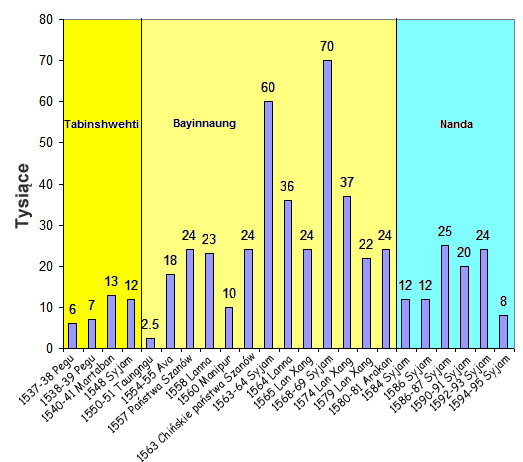
The First Toungoo Empire ended with the death on King Nanda Bayin in 1599. There are Portuguese reports of King Bayinnaung leaving his capital of Pegu with an army one million men as he set out to conquer Ayutthaya, although that is highly unlikely. The Portuguese of the time were often prone to exaggeration, and the logistical difficulties in moving, equipping and feeding an army of that size make the task almost impossible. However, the death toll of all these wars was enormous, as can be seen in the graphic that compares the armies that the Burman kings could field over time.
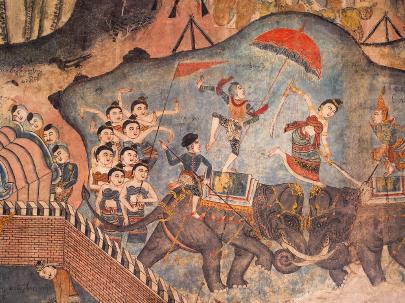
Mural at Wat Nong Bua
Ayutthayan Wall Mural
War was expensive and trade was beneficial. Trade did, however, bring other conflicts that lingered over Ayutthaya until its demise. The Portuguese and the Dutch dominated international trade in South-East Asia during this period. The Portuguese, who first arrived back in 1511, were the purveyors of the modern weapons that ignited what has been known as the period of “The Gunpowder Kings” particularly the Burman kings of Tabinshwehti and Bayinnaung, but they struggled against the mercantile ability of the Dutch when peace resumed.
The Spanish, the return to trade of the Chinese, the feared English, were more concentrated on the Murghal Empire of India, and Japan all feature in the historic record. It was the Dutch who traded over the years, and it was the Dutch who helped as King Phetracha drove the French from Siam. The Dutch, more than anyone persevered in what to them was a very strange land.
Yamada Nagasama was a Japanese trader and adventurer who gain considerable influence in the court of Ayutthaya. He became head of the Japanese village, Ban Yipun, which was highly regarded for its military ability. He rose through the ranks of Thai nobility to gain the title Okya Sensphimuk and supported the military campaigns of King Songtham. As a reward for his exploits he was made governor of (Ligor) Nakon Si Thammarat. He eventaully found himself on the wrong side of King Prasat Thong who arranged for his death in 1630.
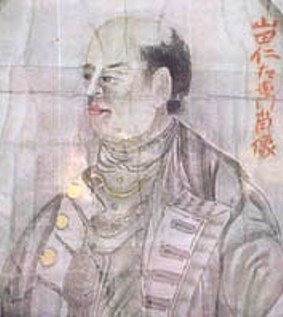
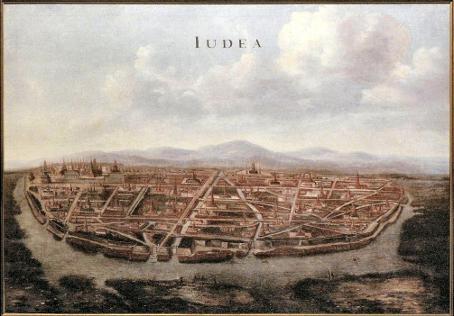
Trade brought a wealth to Ayutthaya and by the year 1700 it was reputed to have one million inhabitants making it the largest city in the world. Merchants from Europe proclaimed the grandeur of the city with its golden palaces, traditional rituals and with a river bustling with ships and boats of all kinds. The wealth changed Ayutthaya gradually breaking down the social order. As a new wealthy class emerged they influenced structures, systems and traditions that had existed for centuries.
King Narai came to the throne, in confrontational circumstances in 1656. His reign, which saw a diiferent approach to kingship than many who had gone before him earned him the soubriquet "the Great." His reign saw the kingdom opened up to the French and to the political games played by Phra Phetracha (later King Phetracha) and the Greek Constantine Phaulkon (the Falcon).
Opposite is a drawing ofthe French demonstrating the telescope to King Narai during a lunar eclipse in 1688.
Map below:Josh at Dutch Wikipedia [GFDL (http://www.gnu.org/copyleft/fdl.html) or CC-BY-SA-3.0 (http://creativecommons.org/licenses/by-sa/3.0/)], via Wikimedia Commonscirca 1665 in Vingboons Atlas
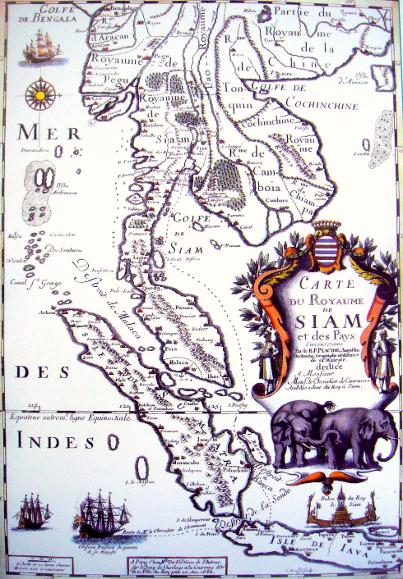
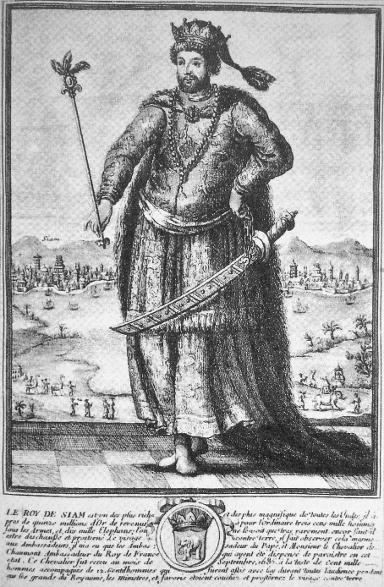
The controversial death of King Narai ushered in the Ban Phlu Luang Dynasty, the final dynasty to rule Ayutthaya, initially under the kingship of King Phetracha. I found King Phetracha to be an embittered man, but one who had a purpose, and that purpose was to become king and to retain his throne. His son, King Suriyenthrathibodi, the "Tiger King" was, arguably, the worst of the Ayutthayan kings. Having said that I found something in him. A fragment in the historic record, which seems unprovable, is that he was dethroned by his two sons following a short civil war. I took this as the basis for a fanciful novel on his life "The Tiger King of Siam," where the king is forced to flee to England and becomes a prizefighter in the stews of London.
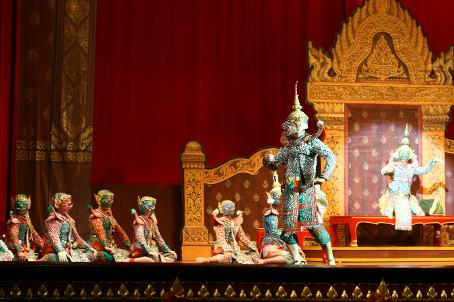
By Kinkku Ananas - Own work, CC BY 3.0, https://commons.wikimedia.org/w/index.php?curid=7291636
The sons of King Suriyenthrathibodi, King Phuminthraracha and King Borommakot oversaw a period that has been described as "Golden Ayutthaya." The city flourished both economically and culturally benefiting from increased trade and the flow of ideas. Trade brought wealth to Ayutthaya and by the year 1700 it was reputed to have one million inhabitants making it the largest city in the world. Merchants from Europe proclaimed the grandeur of the city with its golden palaces, traditional rituals and with a river bustling with ships and boats of all kinds. The wealth changed Ayutthaya gradually breaking down the social order. As a new wealthy class emerged they influenced structures, systems and traditions that had existed for centuries.
The king was challenged to prove his worth against the ten royal virtues by both the nobles and the sangha. King Borommakot, after securing the throne, was a good king and was able to prove himself. His inability to make any meaningful changes to the status of private retainers in his reign did not bode well. As the power of the nobles and the new rich increased, the king found himself under a pressure that previous kings would not have understood. Too parallel it with English history, it was as if his rule by Divine Right was being questioned. Trade was bringing not only wealth, but new ideas.
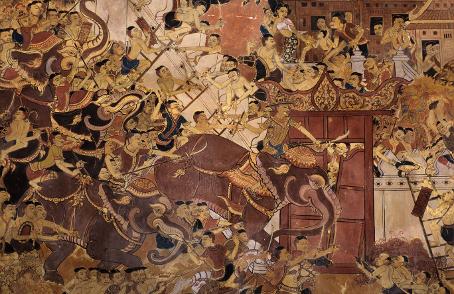
Thai infantry and soldiers riding elephants in mural paintings depicting the fall of Ayutthaya in 1767. From the Audience Hall of Thonburi Palace, Bangkok.
This wealth also brought something else, envy and a chance to right the perceived wrongs of the past. First King Alaungpaya of the second Toungoo Empire failed in his attempt to conquer Ayutthaya, and then his second son, King Hsinbyushin succeeded. Unlike The First Toungoo Empire of King Bayinnaung they were set on looting the city. They would not give up their conquered ground readily, but ambition, revenge and greed were all motivators.
Ayutthaya fell, but the kingdom recovered. That, perhaps, is another story.
